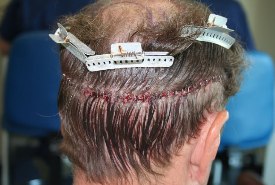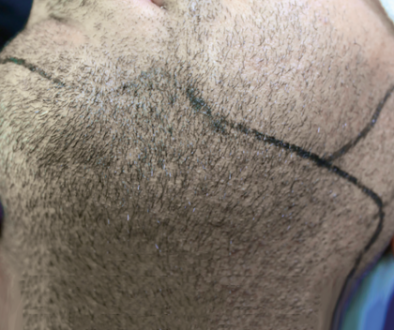Properly Removing Sutures (Stitches) after Hair Transplant Surgery
 One of the most important aspects of a successful Follicular Unit Transplantation (FUT) procedure is a “pencil thin,” easily camouflaged post-operative scar. Although careful strip removal and wound closure are likely the most important elements of proper hair transplant scarring, one other important step is often overlooked: proper suture removal.
One of the most important aspects of a successful Follicular Unit Transplantation (FUT) procedure is a “pencil thin,” easily camouflaged post-operative scar. Although careful strip removal and wound closure are likely the most important elements of proper hair transplant scarring, one other important step is often overlooked: proper suture removal.
In many instances, patients are unable to return to the clinic for suture removal, and hair transplant surgeons instruct these individuals to simply visit another trained health professional for the suture removal. However, although hair restoration physicians have control over the timeline at which patients undergo removal with another individual, they have no control over the skill or professional opinion of the practitioner.
Recently, Coalition hair transplant surgeon Dr. William Lindsey commented on this issue, and explained how improper, untimely suture removal can create an unacceptable hair transplant scar:
We’ve had several recent cases of patients having unremarkable FUT cases at our office, staying for a few days, then returning home and having difficulty getting their sutures removed properly.
One patient went to a clinic, was told by the nurse or doctor that the sutures “weren’t ready to come out” and was told to come back in a few days to a week. Fortunately, he sent me a picture of their donor area, which was completely normal, and I simply asked them to go to another clinic. This was important because sutures left in for too long can leave small, circular scars around the longitudinal strip scar.
In another case, a patient asked their untrained spouse remove the sutures, and the inexperienced removal resulted in unnecessary pulling and tension on the scar. I think this was likely a case of the individual not being comfortable with removing sutures.
Last week, however, we had a nice fellow who’d had a 2500 graft case. We saw him on post-op day 1, cleaned him up and he went sight seeing. On day 3, my lead tech actually drove him to the airport and saw that he looked fine.
On day 7, he emailed me that a nurse had taken out a few sutures and he was bleeding so badly that they had to bandage him up, and he was to come back in a week!!
The miracle of facetime allowed his wife to show us the suture line, which was indeed all torn up in one small area, but also showed us that the rest of the sutures looked fine. We walked his wife through removing the rest of the sutures while I looked on and there was no additional trouble. I expect the nurse who cut out the first 3-5 sutures had little experience, and the supervising consultant had even less.
So this is a caution to our travelling patients: perhaps check with a local clinic before coming for your case to make sure someone can competently take out your sutures post-op; or simply stay and we’ll do it. However, make sure the sutures are removed in a proper, timely manner, or the strip scar may suffer.
____________
Blake Bloxham – formerly “Future_HT_Doc”
Editorial Assistant and Forum Co-Moderator for the Hair Transplant Network, the Hair Loss Learning Center, the Hair Loss Q&A Blog, and the Hair Restoration Forum
Follow our community on Twitter
Watch hair transplant videos on YouTube
Technorati Tags: Follicular Unit Transplantation, FUT, hair transplant scarring, hair transplant surgeons, hair restoration physicians, hair transplant scar, strip scar




May 21, 2014 @ 3:16 am
Dear,
With the help of Strip Hair Transplant local anesthesia given to the donor area of your scalp. A donor strip is then removed and the area is sutured. This typically leaves a fine scar that’s easily hidden by your remaining hair
September 19, 2013 @ 11:12 am
Larry,
Hair transplant suture typically stay in for approximately 1 to 2 weeks depending on the size of the procedure and your doctor’s recommendation. Keeping your sutures in a little longer shouldn’t be a problem.
Best wishes,
Bill – Managing Publisher of this Community
September 18, 2013 @ 4:40 pm
So how long do you recommend the sutures to stay on? My doctor said i can take mine out after 10-14 days but i waited 22 days because i couldn’t find anyone to do it for me. Do you think i waited too long? Thanks!